Historic Hollywood Sites
Re: Historic Hollywood Sites
With all due respect to KISS ME DEADLY, Angel's Flight is best shown off in ANGEL'S FLIGHT (Raymond Nassour/Kenneth Richardson, 1965), an independent, low-budget (natch) noir wherein the funicular plays a key role, symbolically and literally. Definitely worth tracking down (or up).
Everyday people...that's what's wrong with the world. -- Morgan Morgan
I love movies. But don't get me wrong. I hate Hollywood. -- Orson Welles
Movies can only go forward in spite of the motion picture industry. -- Orson Welles
I love movies. But don't get me wrong. I hate Hollywood. -- Orson Welles
Movies can only go forward in spite of the motion picture industry. -- Orson Welles
- Lzcutter
- Administrator
- Posts: 3149
- Joined: April 12th, 2007, 6:50 pm
- Location: Lake Balboa and the City of Angels!
- Contact:
Re: Historic Hollywood Sites

Charlie Chaplin's 1920s home
Charlie Chaplin came to America in 1912 and made his way to Los Angeles. He was originally in the Fred Karno troupe that also included Arthur Stanley Jefferson who would become better known as Stan Laurel. By 1913, Chaplin was working for Mack Sennett at his studio in Edendale, a suburb of Los Angeles. After a shaky start with Sennett (he came close to firing Chaplin after seeing him on film), Chaplin gained popularity quickly. In 1914, he created the character of the Little Tramp when he borrowed shoes from Ford Sterling, pants from Roscoe Arbuckle, cutaway tails from Chester Conklin and donned a crepe moustache. The Little Tramp made his first appearance in the Keystone Comedy, Kid Auto Races in Venice.
In 1915 Chaplin made The Tramp which was hugely popular. Costarring with Chaplin was Edna Purviance. They quickly became a romantic duo and remained that way till 1918 when Chaplin began romancing Mildred Harris. Despite that, Edna remained Chaplin's favorite onscreen partner until 1923 though she remained on Chaplin's payroll well into the 1950s.
In 1919, Chaplin became a partner (along with Doug Fairbanks, Mary Pickford and D.W. Griffith) in United Artists.
The house, pictured above, was in Beverly Hills and designed by Chaplin himself. It was built by studio carpenters and was often called "the Breakaway house" as rumor has it, the house began to fall apart in later years.
For more on Charlie Chaplin: http://myloveofoldhollywood.blogspot.co ... -1977.html
Lynn in Lake Balboa
"Film is history. With every foot of film lost, we lose a link to our culture, to the world around us, to each other and to ourselves."
"For me, John Wayne has only become more impressive over time." Marty Scorsese
Avatar-Warner Bros Water Tower
"Film is history. With every foot of film lost, we lose a link to our culture, to the world around us, to each other and to ourselves."
"For me, John Wayne has only become more impressive over time." Marty Scorsese
Avatar-Warner Bros Water Tower
- Lzcutter
- Administrator
- Posts: 3149
- Joined: April 12th, 2007, 6:50 pm
- Location: Lake Balboa and the City of Angels!
- Contact:
Re: Historic Hollywood Sites
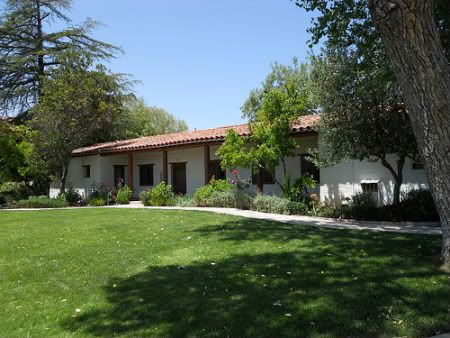
Harry Carey's home in Castaic (located in the Santa Clarita valley north of Los Angeles).
It was over 2,000 acres located north of Saugus. Harry Carey, Sr had been a major western star in the silent era. With his rugged and weather-beaten face, Carey was a natural for westerns. He took to the western lifestyle as well. Navajos worked on the ranch. In fact, Carey's children grew up speaking Navajo (but Dobe says his sister was better at the language than he was.)
In March 1928, Carey was getting ready to go back to New York for a film shoot and the Navajos asked if they could return Arizona and the reservation. Carey asked why and they told him that the St. Francis dam (a large earthen dam supported on both sides by concrete supports) had a crack in it and was leaking. They told him the dam was going to break. Carey gave his okay for Navajos to return to Arizona and he packed up his family and went to New York.
The dam was designed by William Mulholland- the self-taught civic engineer who had made his name designing and building the LA Aqueduct that brought water 233 miles from Owens Valley to Los Angeles (and the water that would turn the San Fernando Valley from agriculture to residential). The dam had been leaking for days and on March 12th, Mulholland had visited the site and declared the dam safe. It broke later that night. The flood waters tore through the canyon destroying everything in it's path including the Carey Ranchero. In fact, debris from the flooding was found on the shores of Ventura, a coastal city about 50 miles from Saugus.
Harry and Olive built a new ranch and home. (Even further from Los Angeles and Hollywood). These folks must have loved the rugged life. The original ranch house at the old homestead had been built out of wood and had caught fire one night and burned down. Though a second house at the old homestead had been built, it too was built out of wood. After losing that home in the flood, Olive Carey wanted a sturdier home. Harry obliged and built her an adobe home.
Carey died in 1947 and Olive in 1988.
A few years ago, the family donated the property to County Parks and Recreation. Today, the home is part of the Tesoro Adobe Historic Park and open to the public.
Lynn in Lake Balboa
"Film is history. With every foot of film lost, we lose a link to our culture, to the world around us, to each other and to ourselves."
"For me, John Wayne has only become more impressive over time." Marty Scorsese
Avatar-Warner Bros Water Tower
"Film is history. With every foot of film lost, we lose a link to our culture, to the world around us, to each other and to ourselves."
"For me, John Wayne has only become more impressive over time." Marty Scorsese
Avatar-Warner Bros Water Tower
Re: Historic Hollywood Sites
Are there any good tour groups which include a lot of these sites? Haven't been to Hollywood in years and don't want to get "ripped off".
Thanks, dickson
Thanks, dickson
- Lzcutter
- Administrator
- Posts: 3149
- Joined: April 12th, 2007, 6:50 pm
- Location: Lake Balboa and the City of Angels!
- Contact:
Re: Historic Hollywood Sites
Dickson,
The Los Angeles Conservancy offers walking tours of the movie palaces in downtown as well as others.
http://www.laconservancy.org/tours/tours_main.php4
The Los Angeles Conservancy offers walking tours of the movie palaces in downtown as well as others.
http://www.laconservancy.org/tours/tours_main.php4
Lynn in Lake Balboa
"Film is history. With every foot of film lost, we lose a link to our culture, to the world around us, to each other and to ourselves."
"For me, John Wayne has only become more impressive over time." Marty Scorsese
Avatar-Warner Bros Water Tower
"Film is history. With every foot of film lost, we lose a link to our culture, to the world around us, to each other and to ourselves."
"For me, John Wayne has only become more impressive over time." Marty Scorsese
Avatar-Warner Bros Water Tower
- Lzcutter
- Administrator
- Posts: 3149
- Joined: April 12th, 2007, 6:50 pm
- Location: Lake Balboa and the City of Angels!
- Contact:
Re: Historic Hollywood Sites
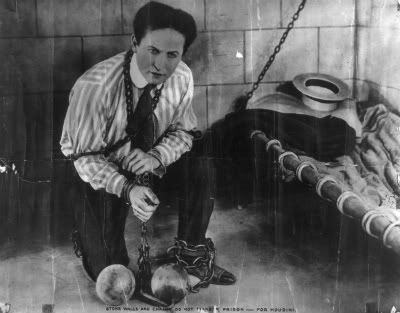
With Halloween coming, it seemed like a good time to turn the spotlight on Harry Houdini. Houdini, they say, was the greatest magician who ever lived. He died on Halloween in 1926. His wife held seances on Halloween for the next ten years trying to contact Harry.
Born Erhich Weiss in Budapest in 1874, his family emigrated to America when he was four years old. His father, a rabbi, settled his family first in Wisconsin and the in New York City. His name Harry, comes from "Ehrie," the diminutive of his name among his family. He became a professional magician at the age of 17, borrowing the name "Houdini" from his hero, French magician, Jean Eugene Robert-Houdin.
In the beginning he did card tricks and eventually moved up to escape -- specifically handcuffs, which got him entree into the world of vaudeville. By this time, he had met and married his wife, Bess Rahner. He began to perform all kinds of escapist stunts, including getting out of straitjackets, chains, and, one of his more famous tricks, The Chinese Water Torture Cell, where he was suspended upside down and chained up in a tank filled with water.
Houdini accomplished his daring escapes by dislocating his shoulders (his brother Theo, who had a shadow career as an escape artist, could only dislocate one shoulder, but Harry could do both), expanding his chest, wrists and shoulders (to make more room while he was being bound) and regurgitating strings, keys and other supplies.
In 1900, he toured in Europe and when he returned in 1904, he was a star.
Houdini was the first magician to operate on such a scale. His earlier tricks were small. He and Bess switched places in locked trunks. He swallowed a needle and thread and regurgitated the needle already threaded. Later, his illusions and escapes were more epic. He went over Niagara Falls, jumped, fully bound in chains, from the Brooklyn Bridge and caused an elephant to disappear.
Long before the James Randi, Houdini made a second career for himself exposing fake spiritualists. Not only did he offer a prize to whatever medium could prove beyond a doubt that they had contacted the other side, but he also disguised himself and went from psychic to psychic in the company of a cop and a reporter. It was through this curious pursuit that he ran afoul of Sir Arthur Conan Doyle -- once a close family friend, who believed in the supernatural quite passionately. After Houdini's death, he published a book in which he postulated the theory that Houdini himself was a psychic so powerful that he could block the powers of those he pretended to be debunking.
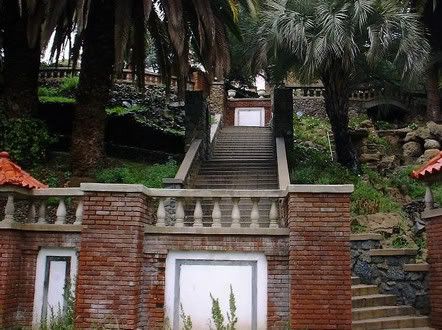
Despite having sought truth so desperately, Houdini's life lends itself to an abundance of apocryphal tales. People don't even know where he lived. Some say that he never lived in Laurel Canyon, others that he lived in a different house than usually thought, further up the canyon, but it burned. The house that people associate with Houdini is more visible from the narrow canyon road. Commuters have viewed its ruined stairs and balustrades for decades -- some have even thought they saw Houdini's ghost wandering through the ruins. In fact this property was owned by the Walkers, a family of furniture entrepreneurs. Bess is listed as living in a guest house that was formerly part of the Walker property some time in the 1930s, long after Houdini's death.
Probably the most well known untruth was propagated by the 1953 film of his life, starring Tony Curtis. In the film, Houdini dies as a result of performing his famous Chinese Water Torture trick, which is completely untrue.
In fact, Houdini died of appendicitis on October 31, 1926. He was fifty-two. In the days before his death, a youth punched him in the stomach several times while he was unprepared, backstage after a show. Part of Houdini's performance was that he invited audience members to punch him, which he was able to withstand by tightening his abdominal muscles (don't try this at home kids!) Many thought this was what killed him. This is not the case -- he was already suffering from the appendicitis, however, it may have prevented Houdini from seeking the medical help he needed.
Houdini, an adventurer to the last, had a bargain with his wife, that whoever died first would visit from the other side and give a coded message if such a thing were possible. Every year, Bess Houdini held a seance. Every year, nothing happened. At the end of the final seance (she passed the tradition on to someone else) in 1936, on the roof of the Knickerbocker Hotel, she blew out the candle she kept lit beside his photo saying: "You can only wait for any man just so long."
Thanks to LAist for the assist!
Lynn in Lake Balboa
"Film is history. With every foot of film lost, we lose a link to our culture, to the world around us, to each other and to ourselves."
"For me, John Wayne has only become more impressive over time." Marty Scorsese
Avatar-Warner Bros Water Tower
"Film is history. With every foot of film lost, we lose a link to our culture, to the world around us, to each other and to ourselves."
"For me, John Wayne has only become more impressive over time." Marty Scorsese
Avatar-Warner Bros Water Tower
- Lzcutter
- Administrator
- Posts: 3149
- Joined: April 12th, 2007, 6:50 pm
- Location: Lake Balboa and the City of Angels!
- Contact:
Re: Historic Hollywood Sites
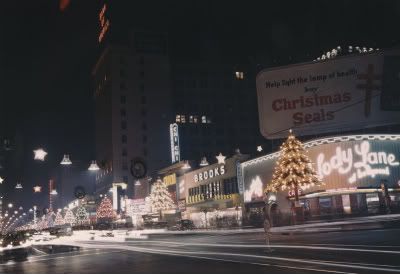
This is Hollywood Blvd and Vine at Christmas circa the 1940s. The 1940s were the Golden Age of Hollywood. On Vine Street, just south of the Blvd (between the two Blvds, Hollywood and Sunset) was Radio Row. NBC Radio was located on Vine as was ABC Radio. CBS Radio was just a few blocks east of Sunset Blvd and Vine at Columbia Square in a beautiful Streamline International building that the network had built for the sole purpose of Radio.
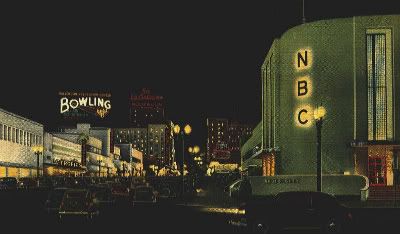

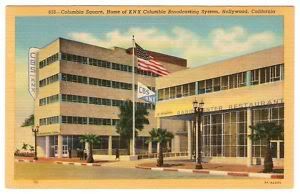
Columbia Studios and Gower Gulch were just east of Columbia Square and accessible to Vine Street either by car or the famed Red Cars transit system.
The famed Hollywood Paladium was there with big bands playing on a nightly basis.
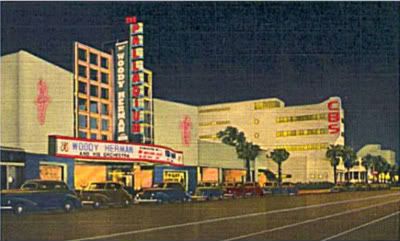
As was the Pantages (just east of Hollywood and Vine) and the famed Palace (just north on Vine).
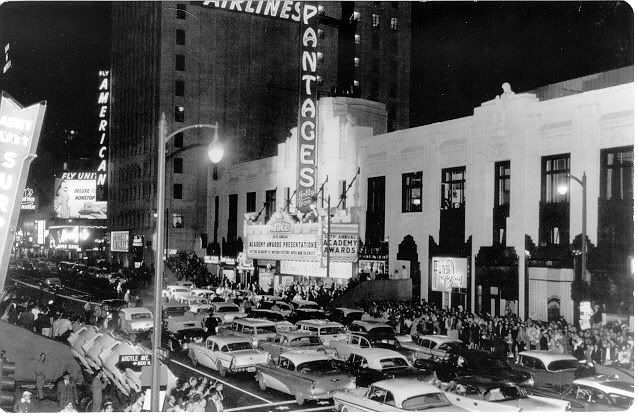
Stars of all caliber went to Hollywood on a regular basis to appear on a variety of Radio Shows or to meet Lolly or Hedda for lunch to ward off any bad press and promote their latest endeavors. High caliber restaurants and movie theaters were located on Hollywood Blvd and both Blvds (Hollywood and Sunset Blvds) were home to a jumping nightlife of night clubs from Sardis to Erroll Carrol's to the Troc to Ciro's.
And the Hollywood Chamber of Commerce made sure that Hollywood Blvd was decked out for Christmas.
Melody Lane was a popular restaurant not only at Hollywood and Vine but also on Wilshire (near LACMA today) and another locale downtown. The kids menu featured the "the little pigs of Ever Ever land".

Directly across the street was the Hollywood Broadway Department store (the roof top neon sign still stands and is lit each night in blue and white neon). The north west corner of Hollywood and Vine where Melody Lane once stood has a varied history.
In 1915, on the corner was the home of George Hoover, an early Hollywood pioneer and land speculator. He was president of the Bank of Hollywood and was a partner in the then-posh Hollywood Hotel located at Hollywood and Highland.
In 1925, Hoover sold the property to "Uncle" Carl Laemmle of Universal Studios fame for $350,000. Laemmle planned to build a 900 seat theater, office building and house a New York department store but those plans never resulted to much. Pictures from the LA Times depict a streamline moderne all glass facade. The Depression likely scuttled Uncle Carl's plans and the property sat vacant with only billboards advertising upcoming Universal movies on the property.
By 1932 Uncle Carl had opened the Coco Tree Cafe. The Coco Tree was designed by famed architect, Richard Neutra and was done in the International style with an all glass front. The front done in glass allowed lots of light to come in and the restaurant had plenty of chrome and linoleum.
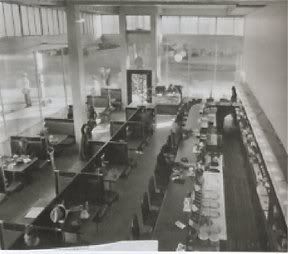
On the outside of the restaurant, Laemmle had advertisements for Universal movies ringing the top.
Other businesses nearby included the famed dining hot spot, Sardis (designed by famed architect Rudolf Shindler), a couple tailoring companies, a men's shop, Radin Jewelry, Vanity Fair Lingerie and Horton & Converse Pharmacy (at 6313 Hollywood Blvd) and the 12 story Guaranty Building.
In 1940, Sidney Hoedemaker, owner of the nearby Pig 'n Whistle, bought the property. He brought in famed Los Angeles architects Wayne McAllister and Charles S. Lee to give the property a make-over. Out was the International style of Neutra and in was the more popular Streamline moderne look.

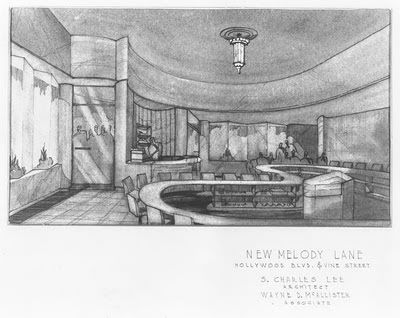
A full dinner would set you back $1.25 and children could eat from the children's Ever Ever Land menu for $.25 to $.45.
Melody Lane stayed on the corner of Hollywood and Vine until the 1950 when it became Hody's (named after Sidney Hoedemaker). The restaurant emphasized service, efficiency and courtesy. I guess good food was a second tier thought.
Though other Hody restaurants around Los Angeles emphasized mid-century modern architecture, the one at Hollywood and Vine kept the look and facade of the former Melody Lane.
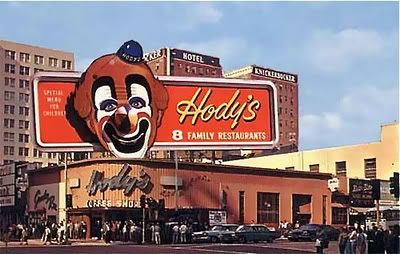
The Ever Ever Land children's menu was replaced by a clown menu that kids could wear.
The restaurant had a 20 year lease on the property. Nearby was an Arthur Murray Dance Studio and a Harris and Frank Clothiers.
In 1969, Sidney Hoedemaker died. The family leased the property to Howard Johnson. The Howard Johnson corporation redesigned the facade to include their famed orange roof and added a small stage for entertainment.
The 1970s and 1980s were not good ones for Hollywood Blvd. The nearby Broadway store closed its door and most of the fashionable businesses followed suit only to be replaced by cut rate tee-shirt and electronic stores.
In the 1990s, the property became home to a number of attempted night clubs that never seemed to work out. In 2008, the corner caught fire and burned. The property remained empty in the aftermath.
Today, a Metro/Subway station is located on the property.
Lynn in Lake Balboa
"Film is history. With every foot of film lost, we lose a link to our culture, to the world around us, to each other and to ourselves."
"For me, John Wayne has only become more impressive over time." Marty Scorsese
Avatar-Warner Bros Water Tower
"Film is history. With every foot of film lost, we lose a link to our culture, to the world around us, to each other and to ourselves."
"For me, John Wayne has only become more impressive over time." Marty Scorsese
Avatar-Warner Bros Water Tower
- Lzcutter
- Administrator
- Posts: 3149
- Joined: April 12th, 2007, 6:50 pm
- Location: Lake Balboa and the City of Angels!
- Contact:
Re: Historic Hollywood Sites

Los Angeles City Hall at Christmas in the 1940s.
The City Hall of the City of Angels has quite the history:
Designed by John Parkinson, John C. Austin and Albert Martin, Sr, City Hall was dedicated on April 26, 1928. At 32 floors and 454 feet tall, it was the tallest building in Los Angeles for over 40 years. It shared the skyline with the Richfield Building (destroyed) and the Eastern Columbia Bldg.
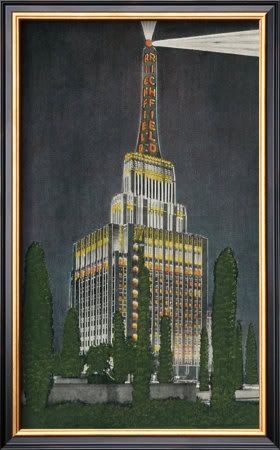
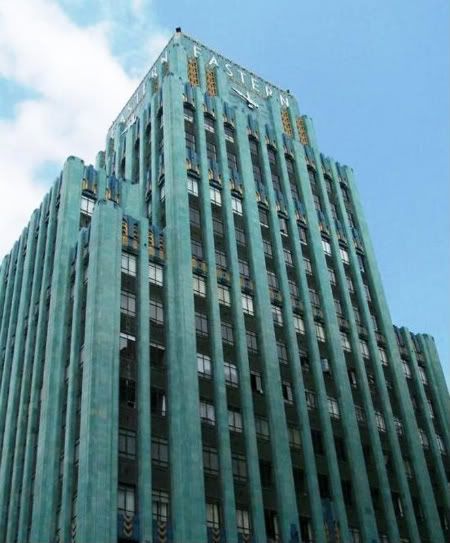
When Los Angeles’s brand new, 28-story City Hall was officially dedicated on April 26, 1928, it was replacing a building on Broadway between 2nd and 3rd Streets that had been government headquarters since 1889. (That building had replaced a one-story adobe City Hall, formerly the old Rocha House, on the northeast corner of Spring and Court Streets.)
After authorizing a bond issue on June 5, 1923, the city commissioned John C. Austin, Albert C. Martin, and John Parkinson as architects in August, 1925. The trio’s deal called for a payment of 6% of the building’s cost. With the project running $5 million, they wound up getting $315,027. Pretty sweet back in 1928, especially in light of the stock market crash a year later.
Ground was broken on March 28th, 1926. Sand from each of California's 58 counties and water from 21 of the historic missions were used in the concrete. The image of City Hall has been on the badges of the LAPD since 1940.

The big dedication ceremony, overseen by theater impresario Sid Grauman, was attended by an estimated 15,000 people, featured emceeing by MGM producer, Joseph Schenck and speeches by Mayor George E. Cryer and San Francisco Mayor James Rolph, Jr. After Rolph spoke, Irving Berlin sang, as did Chief Yowlach, the Yakima Indian chief; Elsa Alsen, the grand opera singer; the Mexican chorus of Los Angeles, in costume; Virgil Johannson, and others.”
The Observation Deck on the 27th floor is open to the public and free of charge.
It was home to the Daily Planet in the Adventures of Superman starring George Reeves as well Dragnet, Perry Mason and Adam-12. It was destroyed by Martians in War of the Worlds, the 1953 version.
It also has a co-starring role in video games such as LA Noire.
It was designated a Historic Cultural Monument in 1976.
In 2002, the interior was restored.
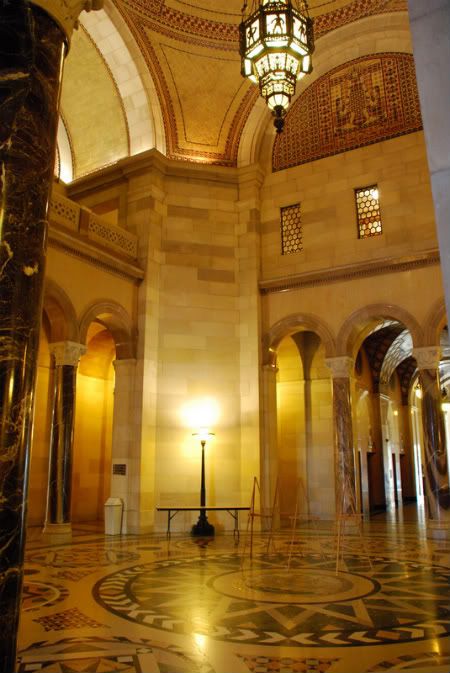

High above its marble floor, the space’s ceiling contains eight figures representing Art, Public Service, Government, Protection, Trust, Education, Health, and Law. Hanging down from its center is a cast bronze electrolier with silhouetted figures of folks instrumental in California history, from Native Indians and Vasca Nunez de Balboa to John Drake Sloat, who raised the U.S flag at Monterey in 1846.
View from the observation deck in 1951 looking towards Hollywood (notice the four level interchange in the foreground):
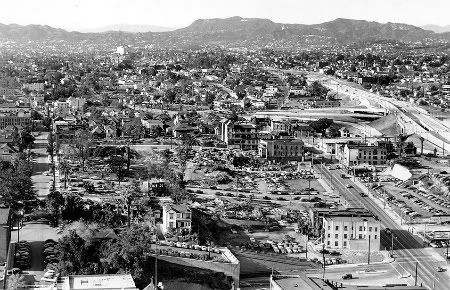
Looking towards Downtown (with Richfield Bldg spire in the foreground) in 1951 from the observation deck:

Lynn in Lake Balboa
"Film is history. With every foot of film lost, we lose a link to our culture, to the world around us, to each other and to ourselves."
"For me, John Wayne has only become more impressive over time." Marty Scorsese
Avatar-Warner Bros Water Tower
"Film is history. With every foot of film lost, we lose a link to our culture, to the world around us, to each other and to ourselves."
"For me, John Wayne has only become more impressive over time." Marty Scorsese
Avatar-Warner Bros Water Tower
- Rita Hayworth
- Posts: 10068
- Joined: February 6th, 2011, 4:01 pm
Re: Historic Hollywood Sites
Lzcutter, you do outstanding work with these posts and make it so enjoyable for all of us here. You never cease to amazed me with your grasp of this subject matter in great detail. Thanks! 
- Lzcutter
- Administrator
- Posts: 3149
- Joined: April 12th, 2007, 6:50 pm
- Location: Lake Balboa and the City of Angels!
- Contact:
Re: Historic Hollywood Sites
kingme,
Thanks for the kind words. I'm getting older and don't always remember all the fun facts that I used to be able to pull up at the drop of a hat. So, I decided to use this thread to put some of that info down on "paper" so to speak and share it with all of you!
Glad you are enjoying it!
Thanks for the kind words. I'm getting older and don't always remember all the fun facts that I used to be able to pull up at the drop of a hat. So, I decided to use this thread to put some of that info down on "paper" so to speak and share it with all of you!
Glad you are enjoying it!
Lynn in Lake Balboa
"Film is history. With every foot of film lost, we lose a link to our culture, to the world around us, to each other and to ourselves."
"For me, John Wayne has only become more impressive over time." Marty Scorsese
Avatar-Warner Bros Water Tower
"Film is history. With every foot of film lost, we lose a link to our culture, to the world around us, to each other and to ourselves."
"For me, John Wayne has only become more impressive over time." Marty Scorsese
Avatar-Warner Bros Water Tower
Re: Historic Hollywood Sites
In the photo looking toward Hollywood you can see the freeways starting to cut a swathe through the neighborhoods.
- Lzcutter
- Administrator
- Posts: 3149
- Joined: April 12th, 2007, 6:50 pm
- Location: Lake Balboa and the City of Angels!
- Contact:
Re: Historic Hollywood Sites
It's the 1940s and Hollywood Blvd is all decked out. This is just east of the famed intersection of Hollywood and Vine and has the famous Pantages Theater in the foreground and the neon sign for the Taft Bld in the background:
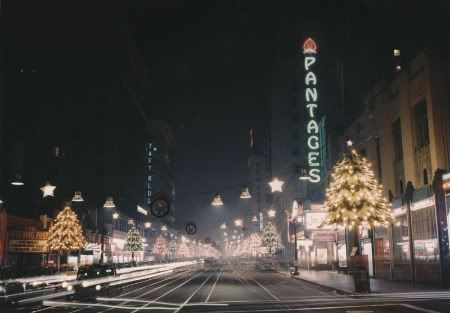
Seattle architect B. Marcus Priteca designed the opulent theater in the Art Deco style that was all the rage in the late 1920s. The flamboyant vaudeville impesario Alexander Pantages was the owner and the Pantages was part of his Theater Circuit. The Pantages opened on June 4, 1930 with the premiere of the Floradora Girl starring Marion Davies. Seating was originally 2812 and the theater operated as both a vaudeville house and a movie theater.
Pantages had gotten his start bringing vaudeville acts to the Yukon during the Alaskan gold rush.
Pantages sold the theater in 1932 to Fox West Coast Theaters in the wake of the famous rape trial that had initially found him guilty and sentenced to 50 years in prison. Hiring Jerry Geisler and Jerry Erhlich (who would both go on to famous legal careers), Pantages was able to win a second trial which resulted in a not guilty verdict and his freedom. But the trials and the ensuing publicity took its toll on his finances.
Fox West Coast Theaters ran the opulent movie palace mainly as movie theater. An exception was in 1940, when the Los Angeles Philharmonic used the theater as its home for its season.
Howard Hughes bought the theater in 1949 under his RKO brand and moved his personal office to the second floor. But Hughes only held on to for a year due to the Paramount Decree. Hughes (and the other studios) were forced to divest their theaters in its wake.
The Academy held its annual Academy Awards ceremony at the theater from 1949-1959.
It hosted 70mm roadshow engagements of Spartacus in 1960 and Cleopatra in 1963. For Spartacus, the seating was reduced to 1500 by draping off the upper balcony and the rear side areas of the main floor. Because of the seating reconfiguration, the Academy had to find a new home for the Oscars.
In 1965, the theater was leased to Pacific Theaters and they bought the theater in 1967.
In 1977, Pacific closed the theater for renovation and Pacific entered into a partnership with the Nederland Organization to turn the theater into a legitimate theater. It opened in with Bubbling Brown Sugar.
The theater was renovated again in 2000 by the Nederland group to the tune of $10 million dollars.
The lobby of the Pantages can be seen in Peter Bogdanovich's At Long Last Love (1975).
Happy Holidays!

Seattle architect B. Marcus Priteca designed the opulent theater in the Art Deco style that was all the rage in the late 1920s. The flamboyant vaudeville impesario Alexander Pantages was the owner and the Pantages was part of his Theater Circuit. The Pantages opened on June 4, 1930 with the premiere of the Floradora Girl starring Marion Davies. Seating was originally 2812 and the theater operated as both a vaudeville house and a movie theater.
Pantages had gotten his start bringing vaudeville acts to the Yukon during the Alaskan gold rush.
Pantages sold the theater in 1932 to Fox West Coast Theaters in the wake of the famous rape trial that had initially found him guilty and sentenced to 50 years in prison. Hiring Jerry Geisler and Jerry Erhlich (who would both go on to famous legal careers), Pantages was able to win a second trial which resulted in a not guilty verdict and his freedom. But the trials and the ensuing publicity took its toll on his finances.
Fox West Coast Theaters ran the opulent movie palace mainly as movie theater. An exception was in 1940, when the Los Angeles Philharmonic used the theater as its home for its season.
Howard Hughes bought the theater in 1949 under his RKO brand and moved his personal office to the second floor. But Hughes only held on to for a year due to the Paramount Decree. Hughes (and the other studios) were forced to divest their theaters in its wake.
The Academy held its annual Academy Awards ceremony at the theater from 1949-1959.
It hosted 70mm roadshow engagements of Spartacus in 1960 and Cleopatra in 1963. For Spartacus, the seating was reduced to 1500 by draping off the upper balcony and the rear side areas of the main floor. Because of the seating reconfiguration, the Academy had to find a new home for the Oscars.
In 1965, the theater was leased to Pacific Theaters and they bought the theater in 1967.
In 1977, Pacific closed the theater for renovation and Pacific entered into a partnership with the Nederland Organization to turn the theater into a legitimate theater. It opened in with Bubbling Brown Sugar.
The theater was renovated again in 2000 by the Nederland group to the tune of $10 million dollars.
The lobby of the Pantages can be seen in Peter Bogdanovich's At Long Last Love (1975).
Happy Holidays!
Lynn in Lake Balboa
"Film is history. With every foot of film lost, we lose a link to our culture, to the world around us, to each other and to ourselves."
"For me, John Wayne has only become more impressive over time." Marty Scorsese
Avatar-Warner Bros Water Tower
"Film is history. With every foot of film lost, we lose a link to our culture, to the world around us, to each other and to ourselves."
"For me, John Wayne has only become more impressive over time." Marty Scorsese
Avatar-Warner Bros Water Tower
- Lzcutter
- Administrator
- Posts: 3149
- Joined: April 12th, 2007, 6:50 pm
- Location: Lake Balboa and the City of Angels!
- Contact:
Re: Historic Hollywood Sites
And this is the other end of Hollywood Blvd in the 1940s (notice the Christmas trees that are the same as in the previous post. I wish the Chamber of Commerce would do these decorations today) near the Chinese Theater. The Roosevelt Hotel is in the background and a corner of neon from the Paramount Theater sign can be seen:
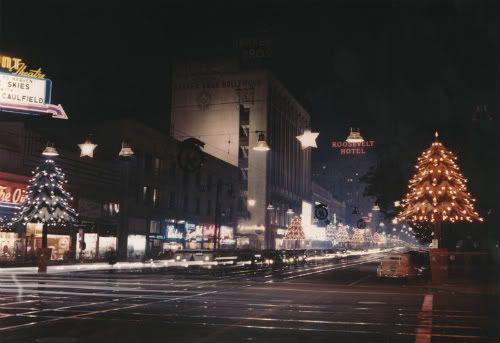
Also looks like an Owl Drug Store in the foreground as well.
When the Roosevelt opened in 1927 it was hailed as the "social occasion of the year" Among those invited were a who's who of the elite of Hollywood at the time: Mary Pickford, Doug Fairbanks, Norma Talmadge and her sister, Constance, Pola Negri, Richard Barthelmess, John Gilbert, Harold Lloyd, Greta Garbo (maybe she attended with Gilbert?), Gloria Swanson, Rod La Rocque, Janet Gaynor, Will Rogers, Clara Bow, Sid Chaplin, Sid Grauman, Wallace Beery and Charlie Chaplin.
According to articles from back in the day, most of them showed up!
The Roosevelt was 12 stories and featured 400 rooms. The Chinese Theater with its famed forecourt and Hollywood premieres was across the street. Those involved in financing the hotel were Fairbanks and Pickford, Joseph Schenck, Louis B. Meyer and Marcus Lowe.
Thanks to Fairbanks, who was president of the Academy at the time, the first Oscar ceremony was held in the Blossom Room (they were called Merit Awards back then) on May 16, 1929.
Ross Columbo broadcast a national radio show from the famed Cinegrill and in the 1950s and 1960s, This is Your Life was telecast live from the hotel.
Shirley Temple is said to have taken tap lessons from Bill "Bojangles" Robinson on the ornate staircase. Lew Ayres is said to have discovered there. Errol Flynn reportedly prepared his gin recipe in the back room of the barber shop during Prohibition. Gable and Lombard stayed in the Penthouse for a whopping $5 a night.
Marilyn Monroe posed on the diving board of the pool for her first suntan lotion print ad.
The owner in the 1950s went about redoing the interior and painting the place sea foam green. In the mid-1980s, Radisson bought the property and spent $35 million restoring the interior and facade to its former glory.
The Roosevelt has appeared on film in Sunset and The Fabulous Baker Boys, Internal Affairs, Beverly Hills Cop, II and Catch Me If You Can as well as guest spots on television in such shows as Moonlighting.
Reports of the Roosevelt being haunted have long been part of its lore. Monty Clift is said to haunt suite #928 on the ninth floor. He stayed at the Roosevelt during the making of From Here to Eternity and is said to have paced the hallways memorizing his lines. Marilyn Monroe is said to appear looking at herself in a mirror that is now located in the lower lobby.
The Roosevelt is the hub for the TCM annual Film Festival in Hollywood.
The Paramount Theater opened in 1926 as a lavish first run legit theater a year before the Chinese Theater made its debut. Called the El Capitan when it opened, the interior was designed with a heavy influence of East India by architect G. Albert Lansburgh. The exterior building, designed by famed Los Angeles architect Stiles O. Clement, in a Spanish Colonial motif included carved icons from drama and literature. The first production at the Paramount was a legit theater offering Charlot's Revue featuring Bea Lilly, Gertrude Lawrence and Jack Buchanan.
In 1942, the theater was converted to a movie theater and renamed the Paramount. Redone in a more Moderne style, Reap the Wild Wind, directed by Cecil B. DeMille, premiered there on March 18, 1942, under the new name. It remained the flagship theater for Paramount until the Supreme Court passed down the Paramount Degree that forced studios to divest their theater holdings.
Constant remodelings dimensioned the opulent interior and the Paramount became a second run theater.
In the 1980s, it was acquired by the Pacific Theater chain where it languished.
In 1989, under a new law that allowed studios to own movie theaters, the Walt Disney Company leased the theater from Pacific. Spending $14 million, they restored the interior to its original opulent design and rebranded it the El Capitan. It became their flagship theater in Hollywood.
It reopened in 1991 with premiere of The Rocketeer. The giant Wurlitzer organ was brought down from San Francisco's Fox Theater.
Next door to the west of the El Capitan is the Masonic Temple that is now the home of Jimmy Kimmel Live and the drug store (formerly Owl's) that at one time had a miniature of Hollywood Blvd from the 1940s in its store window is now a Disney store.
Happy Holidays!

Also looks like an Owl Drug Store in the foreground as well.
When the Roosevelt opened in 1927 it was hailed as the "social occasion of the year" Among those invited were a who's who of the elite of Hollywood at the time: Mary Pickford, Doug Fairbanks, Norma Talmadge and her sister, Constance, Pola Negri, Richard Barthelmess, John Gilbert, Harold Lloyd, Greta Garbo (maybe she attended with Gilbert?), Gloria Swanson, Rod La Rocque, Janet Gaynor, Will Rogers, Clara Bow, Sid Chaplin, Sid Grauman, Wallace Beery and Charlie Chaplin.
According to articles from back in the day, most of them showed up!
The Roosevelt was 12 stories and featured 400 rooms. The Chinese Theater with its famed forecourt and Hollywood premieres was across the street. Those involved in financing the hotel were Fairbanks and Pickford, Joseph Schenck, Louis B. Meyer and Marcus Lowe.
Thanks to Fairbanks, who was president of the Academy at the time, the first Oscar ceremony was held in the Blossom Room (they were called Merit Awards back then) on May 16, 1929.
Ross Columbo broadcast a national radio show from the famed Cinegrill and in the 1950s and 1960s, This is Your Life was telecast live from the hotel.
Shirley Temple is said to have taken tap lessons from Bill "Bojangles" Robinson on the ornate staircase. Lew Ayres is said to have discovered there. Errol Flynn reportedly prepared his gin recipe in the back room of the barber shop during Prohibition. Gable and Lombard stayed in the Penthouse for a whopping $5 a night.
Marilyn Monroe posed on the diving board of the pool for her first suntan lotion print ad.
The owner in the 1950s went about redoing the interior and painting the place sea foam green. In the mid-1980s, Radisson bought the property and spent $35 million restoring the interior and facade to its former glory.
The Roosevelt has appeared on film in Sunset and The Fabulous Baker Boys, Internal Affairs, Beverly Hills Cop, II and Catch Me If You Can as well as guest spots on television in such shows as Moonlighting.
Reports of the Roosevelt being haunted have long been part of its lore. Monty Clift is said to haunt suite #928 on the ninth floor. He stayed at the Roosevelt during the making of From Here to Eternity and is said to have paced the hallways memorizing his lines. Marilyn Monroe is said to appear looking at herself in a mirror that is now located in the lower lobby.
The Roosevelt is the hub for the TCM annual Film Festival in Hollywood.
The Paramount Theater opened in 1926 as a lavish first run legit theater a year before the Chinese Theater made its debut. Called the El Capitan when it opened, the interior was designed with a heavy influence of East India by architect G. Albert Lansburgh. The exterior building, designed by famed Los Angeles architect Stiles O. Clement, in a Spanish Colonial motif included carved icons from drama and literature. The first production at the Paramount was a legit theater offering Charlot's Revue featuring Bea Lilly, Gertrude Lawrence and Jack Buchanan.
In 1942, the theater was converted to a movie theater and renamed the Paramount. Redone in a more Moderne style, Reap the Wild Wind, directed by Cecil B. DeMille, premiered there on March 18, 1942, under the new name. It remained the flagship theater for Paramount until the Supreme Court passed down the Paramount Degree that forced studios to divest their theater holdings.
Constant remodelings dimensioned the opulent interior and the Paramount became a second run theater.
In the 1980s, it was acquired by the Pacific Theater chain where it languished.
In 1989, under a new law that allowed studios to own movie theaters, the Walt Disney Company leased the theater from Pacific. Spending $14 million, they restored the interior to its original opulent design and rebranded it the El Capitan. It became their flagship theater in Hollywood.
It reopened in 1991 with premiere of The Rocketeer. The giant Wurlitzer organ was brought down from San Francisco's Fox Theater.
Next door to the west of the El Capitan is the Masonic Temple that is now the home of Jimmy Kimmel Live and the drug store (formerly Owl's) that at one time had a miniature of Hollywood Blvd from the 1940s in its store window is now a Disney store.
Happy Holidays!
Lynn in Lake Balboa
"Film is history. With every foot of film lost, we lose a link to our culture, to the world around us, to each other and to ourselves."
"For me, John Wayne has only become more impressive over time." Marty Scorsese
Avatar-Warner Bros Water Tower
"Film is history. With every foot of film lost, we lose a link to our culture, to the world around us, to each other and to ourselves."
"For me, John Wayne has only become more impressive over time." Marty Scorsese
Avatar-Warner Bros Water Tower
Re: Historic Hollywood Sites
Lovely posts, Lynn! Thanks for sharing your beloved City Of Angels with all of us.
- Lzcutter
- Administrator
- Posts: 3149
- Joined: April 12th, 2007, 6:50 pm
- Location: Lake Balboa and the City of Angels!
- Contact:
Re: Historic Hollywood Sites
Thanks for the kind words, Knitty.
Looking at Hollywood Blvd today, it can be hard to imagine what it was like back in the 1940s. In addition to the nightclubs, restaurants and movie theaters along the Blvd, there were drug stores, professional offices, jewelry stores and more. In addition to the Broadway Dept. Store, there were small dress shops for women and men's clothing stores.
Back then, Hollywood Blvd catered not only to tourists but also the community who lived around the Boulevard.
With the Paladium, the Palace and NBC, CBS and ABC Radio broadcasting from Hollywood, you had more of a chance of seeing real-life stars in Hollywood back then than you are likely to see one today outside of a major premiere or the TCM Film Festival.
We tend to forget that these days when seeing the modern Hollywood Blvd awash in bargain electronic and tee-shirt stores.
Looking at Hollywood Blvd today, it can be hard to imagine what it was like back in the 1940s. In addition to the nightclubs, restaurants and movie theaters along the Blvd, there were drug stores, professional offices, jewelry stores and more. In addition to the Broadway Dept. Store, there were small dress shops for women and men's clothing stores.
Back then, Hollywood Blvd catered not only to tourists but also the community who lived around the Boulevard.
With the Paladium, the Palace and NBC, CBS and ABC Radio broadcasting from Hollywood, you had more of a chance of seeing real-life stars in Hollywood back then than you are likely to see one today outside of a major premiere or the TCM Film Festival.
We tend to forget that these days when seeing the modern Hollywood Blvd awash in bargain electronic and tee-shirt stores.
Lynn in Lake Balboa
"Film is history. With every foot of film lost, we lose a link to our culture, to the world around us, to each other and to ourselves."
"For me, John Wayne has only become more impressive over time." Marty Scorsese
Avatar-Warner Bros Water Tower
"Film is history. With every foot of film lost, we lose a link to our culture, to the world around us, to each other and to ourselves."
"For me, John Wayne has only become more impressive over time." Marty Scorsese
Avatar-Warner Bros Water Tower
